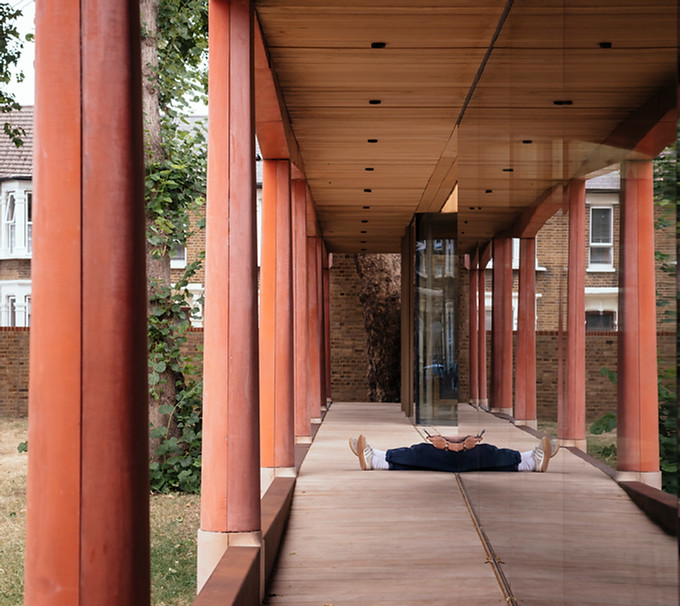


Lea Bridge Library Pavilion
library
-
London, United Kingdom
-
Architects: Studio Wave
-
region:250 square meters
-
year:2021
-
Photos: Jim Stevenson

Text description provided by architects. London-based Studio Weave has expanded the Grade II listed Lea Bridge Library in east London, adding a café and adaptable community space with improved connectivity to the library gardens, revitalizing the civic heart of the Waltham Forest area.

The new 250 square meter wing is located at the rear of the red brick Edwardian library and occupies the western boundary of the site, and is designed to lightly touch the existing heritage building and its green space, Friendship Gardens. Studio Weave used the existing western garden wall as a structural spine, anchoring the structure and the bulk of the building to one side, ensuring a seamless, open connection to the gardens. Cantilever beams of high-strength laminated veneer lumber (LVL) support the length of the upper glazing and floating roof from the rafters. Floor-to-ceiling glazing along the entire eastern elevation attracts the outdoors, creating a visual and physical connection to the Friendship Gardens.

Studio Weave designed the new Lea Bridge Library extension to sit harmoniously among the existing mature trees of Friendship Gardens, resulting in a rectangular floor plan punctuated by a striking semi-circular glass cutout. The wing curves inward and rises at a central pinch point to protect the root system of a mature, adjacent common lemon tree. The architects used this momentary pressure in the plan created by the sweeping concave glazing as an opportunity to divide the pavilion. A wooden door pivots with wall joinery and swings out to create a flexible space for special events, providing a valuable community asset while also securing an additional revenue stream for the library in the future. Tall columns run the length of the new extension, featuring a gently stepped natural stone walkway to ensure access to the rear event space. The façade of gently scalloped red concrete slabs and columns recalls the tone of the brick used in the existing library and hides the drainage that captures water and redirects it to the tree roots below the building.

Accessibility is fundamental to the success and popular use of the Lea Bridge Library Pavilion. Studio Weave designed two new access points to draw visitors through the gardens to the side and rear of the site, bypassing the library's quiet area. The main entrance and foyer on Lea Bridge Road has been renovated to include new laundry facilities, buggy parking and a staff room upstairs. From the lobby, the new café welcomes visitors before opening into the main space. A continuous wall of fluted wood joinery connects bookshelves with built-in banquette seating, creating open "rooms" for reading. The open plan can be adapted to suit a range of cultural, leisure and community activities and can be used at different times of the day by different local groups and library users.

The architects' rigorous approach to sustainability is felt throughout the building. Studio Weave has carefully balanced a light, open-plan community space that benefits from a considered passive cooling strategy supported by mechanical heat recovery ventilation (MVHR). The roof is carefully positioned to protect the exposed gross floor from direct sunlight, and the continuous glass wall opens at intervals to allow natural ventilation.

Reuse is a strong theme throughout the new pavilion. All interior joinery and furniture timbers have been salvaged from felled trees across streets and public parks across London in an effort to reduce the pavilion's carbon footprint and reuse existing waste materials. Rescued tree species include London Plane, Poplar, Sycamore, Ash, Holm Oak, Turkey Oak, Sequoia, Horse Chestnut, and more, and add a rich variety of textures and colors to custom-designed fitted and loose furniture. Studio Weave worked closely with local furniture maker Sebastian Cox, to design a built-in banquette with grooved timber shelving running the length of the pavilion, enhancing the connection to the library while creating a natural visual language echoed by the trees outside in the Friendship Gardens. Sebastian Cox also designed bespoke tables, chairs and sofas for the new space, all made from 25 cubic meters of wood waste.